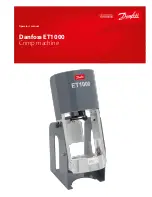
2
850 809 R. 06/18
SAMOA Industrial, S.A. · Pol. Ind. Porceyo, I-14 · Camino del Fontán, 831 · 33392 - Gijón - Spain · Tel.: +34 985 381 488 · www.samoaindustrial.com
2018_06_05-11:30
EN
DESCRIPTION
Compact hose reels for use with compressed air. These hose reels are made of moulded steel and are electrostatic powder painted. A locking
mechanism allows to uncoil the hose and lock it at the desired length. The locking mechanism is released by gently pulling the hose, which is
automatically recoiled.
Do never exceed the max working pressure (see technical information).
INSTALLATION
The hose reel can be wall mounted or mounted on the ceiling, (fig. 2
and 3).
NOTE:
The hose reel must be installed at a minimum height of 2.5 m
over the floor.
• Install the hose reel on a solid wall or ceiling with a smooth surface
using two ø 8 mm screws.
• Do always connect the hose reel to the air line by means of a flexible hose.
• Install an air shut off valve between the line and the hose reel for
safety and for ease of maintenance.
IMPORTANT:
The manufacturer declines all responsibility of injury or
damages caused by an incorrect installation.
Fig. 3
IMPORTANT:
Maintenance must only be carried out by trained staff and in accordance with the instructions given in this manual.
• The automatic locking mechanism is operating on one half of a turn of the drum and is released by gently pulling the hose.
• Do always hold the hose back when rewinding in order to avoid malfunction and injuries to people.
• Check periodically all connections and the hose for wear or damage and the hose reel for a correct operation. Replace damaged parts with
original spare parts.
• Lubricate with oil the swivel and the shaft through the hexagonal hole in the casing (part numbers 500110 and 500111).
Fig. 2
OPERATION AND MAINTENANCE
HOSE REPLACEMENT
WARNING:
Before carrying out the hose replacement, assure that the
air supply is shut off, the hose is without pressure and the spring is
unloaded.
1.
Unscrew and remove the swivel as shown in figure 4a and 5a (see
drawing related to the corresponding part nr).
2. Turn the hose reel upside down and insert a hexagonal wrench to
hold back the shaft. Loosen the two screws (part numbers 500110
and 500111, fig 4b) or the nut (Part nr 500115 and 500116, fig 5b)
and gently turn the wrench clockwise to unload the spring.
3.
Unscrew the four screws that hold the two covers together and
remove the covers and the rollers support (fig 4c and fig 5c).
WARNING:
Do not open the spring housing. The spring must only
be replaced by qualified staff.
4.
Turn the drum upside down and remove the latch and the latch
spring (part nr 500110 and 500111,figure 4d); Turn the drum
upside down and take the spring hub out of the drum (part nr
500115 and 500116, fig 5d).
5.
Put two screw drivers into the slots and lift out the lid (part nr
500110 and 500111,figure 4e); Unfasten the central screw and
remove the bushing (part nr 500115 and 500116, fig 5e).
6.
Loosen the hose connection and replace the hose.
7.
Connect a new hose to the drum, inserting it through the rollers
support (fig 4f and 5f). Mount the hose stop at the desired distance
from the end.
8.
Reassemble the hose reel reversing each step. Lubricate the latch
and the drum bearing if necessary.
9.
When the covers are assembled, insert the hexagonal wrench and
turn it counter clockwise until the hose stop reaches the roller
support. Turn two more turns to load the spring.
10.
Hold the hexagonal wrench firmly while fastening the two screws
(Part nr 500110 and 500111), or the nut (part nr 500115 and
500116). Check the correct operation by pulling out and rewinding
it completely. Adjust the spring load if necessary Lubricate the
swivel (only Part nr 500110 and 500111) and mount it.



































